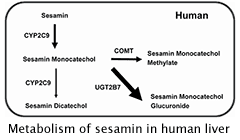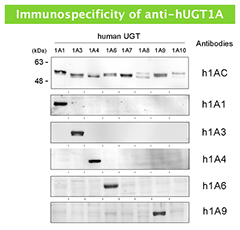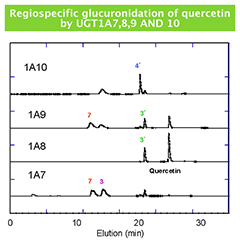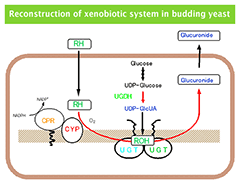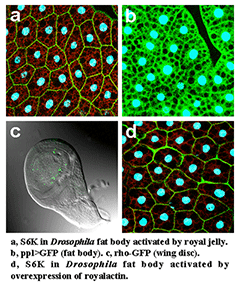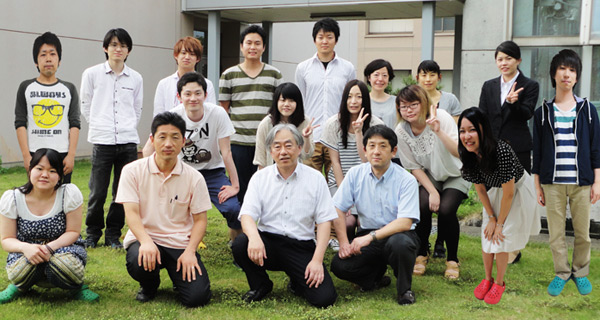
Research Field
- Studies on molecular mechanism of metabolism of biofactors including physiological and dietary compounds. ;Enzyme chemistry of cytochrome P450 and UDP-Glucuronosyltransferase. ;Analysis of metabolites of biofactors using recombinant human enzymes expressed in E. coli or yeast cells.
- Studies on molecular mechanism through which developmental signals regulate morphogenesis in animals during developmental period.
Recent Research Themes
- Metabolism of vitamin D and its analog by cytochrome P450.
- Glucuronidation of dietary compounds including bioflavonoids.
- Bioconversion of fine chemical compounds using cytochrome P450-dependent monooxygenase reaction and UDP-glucuronosyltransferase.
- Mechanism underlying caste differentiation in honeybees.
- Developmental signals regulating body size and morphogenesis.
Research Interest
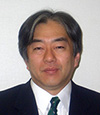 Prof. Tashiyuki Sakaki |
 Associate Prof. Shinichi Ikushiro |
 Lecturer. Masaki Kamakura |
|---|---|---|
|
Structure and function of UDP-glucuronosyltransferase and its application for xennobiotics. | Regulation of developmental signals regarding morphogenesis in animals. |
Address:
Laboratory of Food Science and Technology,
Department of Biotechnology, Toyama Prefectural University,
Kurokawa 5180, Imizu, Toyama 939-0398, JAPAN
TEL: +81-766-56-7500
FAX: +81-766-56-2498
E-mail:
tsakaki_AT_pu-toyama.ac.jp (T.Sakaki)
ikushiro_AT_pu-toyama.ac.jp (S.Ikushiro)
kamakura_AT_pu-toyama.ac.jp (M. Kamakura)
PLEASE REPLACE '_AT_' WITH '@'
Project
(1) Structure-function analysis of mammalian vitamin D hydroxylases
The vitamin D3 25-hydroxylases (CYP27A1 and CYP2R1), 25-hydroxyvitamin D3 1 α-hydroxylase (CYP27B1) and 1α,25-dihydroxyvitamin D3 24-hydroxylase (CYP24A1) are members of the cytochrome P450 superfamily, and key enzymes of vitamin D3 metabolism. Using the heterologous expression in E. coli (mitochondrial CYP27A1, CYP27B1, and CYP24A1) or S. cerevisiae (microsomal CYP2R1), enzymatic properties of the P450s were examined in detail. Upon analyses of the metabolites of vitamin D3 by the reconstituted system, CYP2R1 catalyzed 25-hydroxylation of vitamin D3, but CYP27A1 produced at least seven minor metabolites including 1 α,25(OH)2D3 in addition to the major metabolite 25(OH)D3. These results indicated that human CYP27A1 catalyzes multiple reactions involved in the vitamin D3 metabolism. In contrast, CYP27B1 only catalyzes the hydroxylation at C-1 α position of 25(OH)D3 and 24R,25(OH)2D3. Enzymatic studies on substrate specificity of CYP27B1 suggest that the 1 α-hydroxylase activity of CYP27B1 requires the presence of 25-hydroxyl group of vitamin D3 and is enhanced by 24-hydroxyl group while the presence of 23-hydroxyl group greatly reduced the activity. Eight types of missense mutations in the CYP27B1 gene found in vitamin D-dependent rickets type I (VDDR-I) patients completely abolished the 1α-hydroxylase activity. A three-dimensional model of CYP27B1 structure simulated on the basis of the crystal structure of rabbit CYP2C5 supports the experimental data from mutagenesis study of CYP27B1 that the mutated amino acid residues may be involved in protein folding, heme-propionate binding or activation of molecular oxygen. CYP24A1 expressed in E. coli showed a remarkable metabolic processes of 25(OH)D3 and 1α,25(OH)2D3. Rat CYP24A1 catalyzed six sequential monooxygenation reactions that convert 1α,25(OH)2D3 into calcitroic acid, a known final metabolite of C-24 oxidation pathway In addition to the C-24 oxidation pathway, human CYP24A1 catalyzed also C-23 oxidation pathway to produce 1α,25(OH)2D3-26,23-lactone. Surprisingly, more than 70 % of the vitamin D metabolites observed in a living body were found to be the products formed by the activities of CYP27A1, CYP27B1, and CYP24A1.

(2) Metabolism of vitamin D analogues
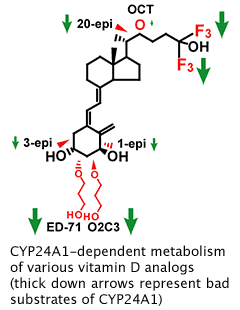
Vitamin D analogs are potentially useful for clinical treatments of type I rickets, osteoporosis, renal osteodystrophy, psoriasis, leukemia, and breast cancer. On the use of vitamin D analogs, the information of metabolism in target tissues such as kidney, small intestine, and bones is pharmacologically essential. CYP24A1 is considered to be associated with the major metabolic pathways of the vitamin D analogs in these tissues. Species-based difference on the metabolism of vitamin D3 analogs appears to be originated from the difference of CYP24A1-dependent reactions. Since human kidney specimen is not easily obtained and substrate specificities of CYP24A1 vary among species, the development of an in vitro system containing human CYP24A1 was essential for the prediction of the drug metabolism in human kidney. We examined CYP24A1-dependent metabolism of such vitamin D analogs as A-ring diastereomers and 20-epimer of 1α,25(OH)2D3, 2α-propoxy- 1α,25(OH)2D3 2α-(3-hydroxypropoxy)- 1α,25(OH)2D3, and 26,26,26,27,27,27- F6-1α,25(OH)2D3. Good correlation was observed between increasing effect on serum calcium level in rats and kcat/Km value of CYP24A1 for each of the vitamin D analogs. In addition, species-based difference was also observed in CYP24A1-dependent metabolism of vitamin D analogs between humans and rats. These results strongly suggest the usefulness of the recombinant systems harboring CYP24A1 for predicting the metabolism and efficacy of vitamin D analogs before clinical trials.
(3) Structure-function analysis of mammalian cytochromes P450
(i) Prediction of dioxin metabolism in human liver
Metabolism of polychlorinated dibenzo-p-dioxins by cytochrome P450 (P450) and UDP-glucuronosyltransferase (UGT) was examined using a recombinant enzyme system and human liver microsomes. A good correlation (R = 0.92) was observed between 2,3,7-triCDD 8-hydroxylation and phenacetin O-deethylation in human liver microsomes, suggesting that CYP1A2 is responsible for 2,3,7-triCDD 8-hydroxylation in human livers. On the other hand, multiple human UGT isozymes showed glucuronidation activity toward 8-hydroxy-2,3,7-triCDD (8-OH-2,3,7-triCDD). Of these UGTs, UGT1A1, 1A9, and 2B7, which are constitutively expressed in human livers, showed remarkable activity toward 8-OH-2,3,7-triCDD. These results strongly suggest that 2,3,7-triCDD would be firstly converted to 8-OH-2,3,7-triCDD by CYP1A2, then further converted to its glucuronide by UGT1A1, 1A9, and 2B7 in human liver.
(ii) Generation of 2,3,7,8-TCDD-metabolizing enzyme by site-directed mutagenesis of rat CYP1A1
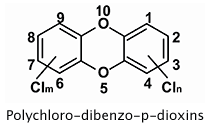
Our previous studies revealed that mono-, di-, and tri-chloro-dibenzo-p-dioxins were good substrates of rat CYP1A1. However, rat CYP1A1 showed no activity toward 2,3,7,8-TCDD. Based on these results, we assumed that enlarging the space of substrate-binding pocket of rat CYP1A1 might generate the catalytic activity toward 2,3,7,8-TetraCDD. Large-sized amino acid residues located at putative substrate-binding sites of rat CYP1A1 were substituted for alanine by site-directed mutagenesis. Among the mutants examined, F240A showed a conversion of 2,3,7,8-TCDD to 8-hydroxy-2,3,7-triCDD. To our best knowledge, the F240A mutant of rat CYP1A1 is the first enzyme to be verified as a 2,3,7,8-TCDD-metabolizing enzyme. In addition, we successfully expressed N-terminal truncated F240A mutant (ΔF240A) in E. coli cells. These results suggest possible application of fungal or prokaryotic cells expressing F240A or ΔF240A to the bioremediation of PCDD- contaminated soil.
(iii) Prediction of sesamin metabolism in human liver
We examined metabolism of sesamin by cytochrom P450 (P450) using yeast expression system and human liver microsomes, and found that CYP2C9 was the most important P450 isoform for sesamin catecolization in human liver. We also found a weak mechanism-based inhibition of CYP2C9 by sesamin. Next step, we focused on the metabolism of sesamin monocatechol that was further converted into the dicatechol form by cytochrome P450 or the glucuronide by UDP-glucuronosyltransferase (UGT). Catecholization of sesamin monocatechol enhances its anti-oxidant activity, whereas glucuronidation strongly reduces its anti-oxidant activity. In human liver microsomes, the glucuronidation activity was much higher than the catecholization activity toward sesamin monocatechol. Kinetic studies using recombinant human UGT isoforms identified UGT2B7 as the most important UGT isoform for glucuronidation of sesamin monocatechol.
We also observed the methylation activity toward sesamin monocatechol by catechol O-methyl transferase (COMT) in human liver cytosol. Based on these results, we concluded that CYP2C9, UGT2B7, and COMT played essential roles in the metabolism of sesamin in the human liver.
(4) Protein engineering of St. griseolus CYP105A1 for production of 1α,25-dihydrovitamin D3
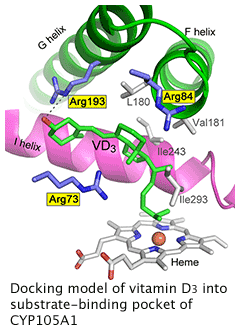
CYP105A1 from Streptomyces griseolus has the capability of converting vitamin D3 (VD3) to its active form, 1α,25-dihydroxyvitamin D3 (1α,25(OH)2D3) by a two-step hydroxylation reaction. Our crystal structure analysis has suggested that Arg73 and Arg84 are key residues for the activities of CYP105A1. Thus, we prepared a series of single and double mutants by site-directed mutagenesis focusing on these two residues of CYP105A1 to obtain the hyperactive vitamin D3 hydroxylase. The double mutant R73V/R84A exhibited 435- and 110-fold higher kcat/Km values for the 25-hydroxylation of 1α-hydroxyvitamin D3 and 1α-hydroxylation of 25-hydroxyvitamin D3, respectively, compared with the wild-type enzyme. These values notably exceed those of CYP27A1, which is the physiologically essential VD3 hydroxylase. Thus, we successfully generated useful enzymes of altered substrate preference and hyperactivity. Structural and kinetic analyses of single and double mutants suggest that the amino acid residues at 73 and 84 positions affect the location and conformation of the bound compound in the reaction site, and those in the transient binding site, respectively.
(5) Structure and function of UDP-glucuronosyltransferase
UDP-glucuronosyltransferases (UGTs) play an important role in the metabolism of a broad range of xenobiotic and endogenous compounds. UGT catalyzes the transfer of a glucuronic acid group to a variety of functional groups on the substrates. Expression of UGT in mammals is thought to be regulated in both a tissue- and developmental-specific manner. Furthermore, induction of genes encoding UGT occurs after exposure to xenobiotics including drugs, environmental pollutants and dietary compounds. In human, isoforms of UGT1A subfamily catalyze the glucuronidation of a greater proportion of drugs, suggesting that the expression of UGT1A isoforms is responsible for the clearance of a diverse range of drugs. To analyze the expression of rat and human UGT1A isoforms, we have developed polyclonal antibodies against specific peptide regions within the isoforms (UGT1A1, 1A3, 1A4, 1A6 and 1A9) and C-terminal common region. The prepared antipeptide antibodies were found to be highly monospecific for each UGT1A isoform and no cross-reactivity with UGT2B isoforms was detected. Analysis of UGT1A protein levels in human hepatic microsomes using these antibodies demonstrated interindividual differential expression of each isoform. The range of UGT1A and UGT1A1 content was 4.5 and 4.8-fold, respectively. These monospecific antipeptide antibodies against human UGT1A isoforms provide an important tool to analyze tissue distribution and interindividual expression levels of UGT1As.
In addition to drugs and environmental pollutants, dietary compounds including plant secondary metabolites are glucuronidated by UGT isoforms and its biological effects such as antioxidant capacity depend, in partly, on formation of the glucuronides. To evaluate the contribution of each UGT isoforms responsible for glucuronidation towards one of the dietary bioflavonoid, quercetin, we have constructed heterologus expression system of rat and human UGT1A and UGT2B isoforms ,and analyzed the glucuronidation using the recombinant UGTs. Formation of quercetin glucuronides was analyzed by UV-HPLC using C30 reverse phase column. Rat and human UGT1A1 catalyzed glucuronidation towards 3’- and 4’-hydroxyl moiety of B-ring in quercetin with high catalytic efficiency and substrate inhibition kinetics. In contrast, both UGT1A6 were unable to catalyze the glucuronidation of any hydroxyl moiety. In human, UGT1A9 produced 3’-, 4’-, 3- and 7-glucuronides. Most UGT2B isoforms in rat and human did not catalyze the quercetin glucuronidation. UGT2B1 in rat and UGT2B7 in human have a moderate activity for quercetin. Extrahepatic human UGT1A7, UGT1A8 and UGT1A10, which are found throughout the gastrointestinal tract, show the high glucuronidation efficiency towards 3-, 3’- and 4’-hydroxyl moiety, respectively. These isoforms have a regioselectivity of glucuronidating site in quercetin in spite of highly similarity of amino acid sequences. These results suggest that glucuronidation towards quercetin are catalyzed by several UGT isoforms, and recombinant rat and human UGT expression system provides information on the regioselectivity of glucuronidation of dietary bioflavonoids.
(6) Analysis of drug and dietary compounds by xenobiotic metabolizing enzymes
Glucuronidation, which is catalyzed by isoforms of UDP-glucuronosyltransferases (UGT), is the most common pathway for detoxification and elimination of hydrophobic xenobiotics occurring in tissues of most mammals. Because of their ubiquitous nature and high physiological significance, development of an efficient in vitro synthesis of glucuronides often becomes critical during studies of drug metabolism undertaken in the development of a new pharmaceutical product. Glucuronides have been obtained by chemical synthesis, by tedious isolation and purification of in vivo metabolites from biological samples of experimental animals, and by biosynthesis using hepatic microsomes as enzyme source. In order to synthesize the glucuronides as drug metabolites, we have now developed several mammalian CYP, UGT and UDP-glucose dehydrogenase (UGDH) coexpression systems in budding yeast.
We have previously constructed the expression system of several mammalian CYP and UGT isoforms in budding yeast cells, Saccharomyces cerevisiae AH22, to analyze the structure and function of these xenobiotic metabolizing enzymes. Yeast cells lack the ability of production of UDP-glucuronic acid (UDP-GlcUA) from UDP-glucose to synthesize the glucuronide in whole cells. To achieve the production of UDP-GlcUA for co-substrate of glucuronidation, UGDH gene deriver from rat or plant was introduced to yeast cell. Most glucuronide was found in reaction medium with time-dependent production, suggesting the functional expression of both enzymes and the presence of endogenous transport system for glucuronide in yeast. Optimization of the reaction conditions resulted in 95% conversion of 7-hydroxycoumarine(7HC) into its glucuronide. Compared with fission yeast system as host cell , budding yeast appears to be more competent for glucuronide formation. Mycophenolic acid with multiple glucuronidating sites was conjugated as UGT isoform-dependent formation, suggesting that the regiospecific glucuronides of several drugs could be obtained using UGT1A and 2B isoforms. In order to synthesize glucuronide from CYP-dependent metabolite during Phase I and II processes, rat CYP1A1 and yeast NADPH-P450 reductase were coexpressed with UGT in yeast. The resultant recombinant yeast cells with xenobiotic metabolizing enzymes was able to produce directly the glucuronide from 7-ethoxycoumarin via 7HC. This coexpression system of mammalian CYP, UGT and UGDH in budding yeast would be a powerful tool for enzyme-assisted synthesis of various xenobiotic metabolites including glucuronides.
(7) Study on developmental biology-1: Investigation of mechanism underlying caste differentiation in honeybees.
The honeybee (Apis mellifera) forms two female castes, the queen and the worker. This dimorphism depends not on genetic differences, but on ingestion of royal jelly (RJ), though the mechanism through which RJ regulates caste differentiation has long remained unknown. Here I show that a 57-kDa protein in RJ, designated as royalactin in a previous report, induces differentiation of honeybee larvae into queens. Royalactin increased body size and ovary development and shortened developmental time in honeybee. Surprisingly, it also showed similar effects in fruit fly (Drosophila melanogaster). Mechanistic studies revealed that royalactin activated p70 S6 kinase, which was responsible for the increase of body size, increased the activity of mitogen-activated protein kinase (MAP kinase), which was involved in the decrease of developmental time, and increased the titer of juvenile hormone (JH), an essential hormone for ovary development. These actions were mediated by epidermal growth factor receptor (Egfr) in fat body of both insects, because knockdown of Egfr expression resulted in a defect of all phenotypes induced by royalactin. Thus, these findings indicate that a specific factor in RJ, royalactin, drives queen development through an Egfr-mediated signaling pathway.
(8) Study on developmental biology-2: Investigation of developmental signals regulating body size and morphogenesis.
The environmental cues during developmental period influence animal cell growth and histogenesis to change phenotypes of individuals. In this study, we investigate how intracellular signaling pathways, juvenile hormone-regulating signals and ecdysone receptor signalling factors control body size and morphogenesis in Drosophila and honeybees.
Publications
2016
- Ikushiro S, Nishikawa M, Masuyama Y, Shouji T, Fujii M, Hamada M, Nakajima N, Finel M, Yasuda K, Kamakura M, Sakaki T.
Biosynthesis of Drug Glucuronide Metabolites in the Budding Yeast Saccharomyces cerevisiae.
Mol Pharm. 13, 2274-2282 (2016) - Mise S, Haga Y, Itoh T, Kato A, Fukuda I, Goto E, Yamamoto K, Yabu M, Matsumura C, Nakano T, Sakaki T, Inui H.
Structural Determinants of the Position of 2,3',4,4',5-Pentachlorobiphenyl (CB118) Hydroxylation by Mammalian Cytochrome P450 Monooxygenases.
Toxicol Sci. pii: kfw086 (2016) - Hayashi K, Yasuda K, Yogo Y, Takita T, Yasukawa K, Ohta M, Kamakura M, Ikushiro S, Sakaki T.
Sequential hydroxylation of vitamin D2 by a genetically engineered CYP105A1.
Biochem Biophys Res Commun. 473, 853-858 (2016) - Corcoran A, Nadkarni S, Yasuda K, Sakaki T, Brown G, Kutner A, Marcinkowska E.
Biological Evaluation of Double Point Modified Analogues of 1,25-Dihydroxyvitamin D2 as Potential Anti-Leukemic Agents.
Int J Mol Sci. 17, e91 (2016) - Munetsuna E, Kittaka A, Chen TC, Sakaki T.
Metabolism and Action of 25-Hydroxy-19-nor-Vitamin D3 in Human Prostate Cells.
Vitam Horm. 100, 357-377 (2016) - Nakamura T, Miyoshi N, IshiiT, , Nishikawa M, Ikushiro S, Watanabe T.
Activation of transient receptor potential ankyrin 1 by quercetin and its analogs.
Biosci Biotechnol Biochem. 80, 949-954 (2016)
2015
- Yasuda K, Ueno S, Ueda E, Nishikawa M, Takeda K, Kamakura M, Ikushiro S, Sakaki T.
Influence of sesamin on CYP2C-mediated diclofenac metabolism: in vitro and in vivo analysis.
Pharmacol Res Perspect. 3, e00174 (2015) - Shirotani N, Togawa M, Ikushiro S, Sakaki T, Harada T, Miyagawa H, Matsui M, Nagahori H, Mikata K, Nishioka K, Hirai N, Akamatsu M.
Identification and in silico prediction of metabolites of the model compound, tebufenozide by human CYP3A4 and CYP2C19.
Bioorg Med Chem. 23, 6594-6601 (2015) - Mano H, Nishikawa M, Yasuda K, Ikushiro S, Saito N, Takano M, Kittaka A, Sakaki T.
Development of Novel Bioluminescent Sensor to Detect and Discriminate between Vitamin D Receptor Agonists and Antagonists in Living Cells.
Bioconjug Chem., 26, 2038-2045 (2015) - Bolla NR, Corcoran A, Yasuda K, Chodyナгki M, Krajewski K, Cmoch P, Marcinkowska E, Brown G, Sakaki T, Kutner A.
Synthesis and evaluation of geometric analogs of 1ホア,25-dihydroxyvitamin D2 as potential therapeutics.
J Steroid Biochem Mol Biol. pii: S0960-0760(15)30057-1 (2015) - Takano M, Yasuda K, Higuchi E, Tohyama E, Takeuchi A, Sakaki T, Kittaka A.
Synthesis, metabolism, and biological activity of 2-[3-(tetrazolyl)propyl]-1ホア,25-dihydroxy-19-norvitamin D3.
J Steroid Biochem Mol Biol. pii: S0960-0760(15)30029-7 (2015) - Yasuda K, Iwanaga Y, Ogawa K, Mano H, Ueno S, Kimoto S, Ohta M, Kamakura M, Ikushiro S, Sakaki T.
Human hepatic metabolism of the anti-osteoporosis drug eldecalcitol involves sterol C4-methyl oxidase.
Pharmacol Res Perspect., 3, e00120 (2015) - Watanabe KP, Kawai YK, Nakayama SM, Ikenaka Y, Mizukawa H, Takaesu N, Ito M, Ikushiro SI, Sakaki T, Ishizuka M.
Partial cloning of CYP2C23a genes and hepatic protein expression in eight representative avian species.
Journal of Veterinary Pharmacology and Therapeutics, 38, 190-195 (2015) - Takano M, Sawada D, Yasuda K, Nishikawa M, Takeuchi A, Takagi K, Horie K, Reddy GS, Chen TC, Sakaki T, Kittaka A.
Synthesis and metabolic studies of 1ホア,2ホア,25-, 1ホア,4ホア,25- and 1ホア,4ホイ,25-trihydroxyvitamin D3.
J Steroid Biochem Mol Biol. 148, 34-37 (2015) - Maruo Y, Behnam M, Ikushiro S, Nakahara S, Nouri N, Salehi M.
Two Different UGT1A1 Mutations causing Crigler-Najjar Syndrome types I and II in an Iranian Family.
J Gastrointestin Liver Dis. 24, 523-526 (2015)
2014
- Inui H, Itoh T, Yamamoto K, Ikushiro S, Sakaki T.
Mammalian cytochrome P450-dependent metabolism of polychlorinated dibenzo-p-dioxins and coplanar polychlorinated biphenyls.
Int J Mol Sci., 15, 14044-14057 (2014) - Rhieu SY, Annalora AJ, Laporta E, Welsh J, Itoh T, Yamamoto K, Sakaki T, Chen TC, Uskokovic MR, Reddy GS.
Potent Antiproliferative Effects of 25-Hydroxy-16-ene-23-yne-vitamin D3 That Resists the Catalytic Activity of Both CYP27B1 and CYP24A1.
J Cell Biochem. 115, 1392-1402 (2014) - Nakamura T, Murota K, Kumamoto S, Misumi K, Bando N, Ikushiro S, Takahashi N, Sekido K, Kato Y, Terao J.
Plasma metabolites of dietary flavonoids after combination meal consumption with onion and tofu in humans.
Molecular Nutrition & Food Research. 58, 310-317 (2014) - Munetsuna E, Kawanami R, Ikeda S, Nakabayashi S, Yasuda K, Ohta M, Kamakura M, Ikushiro S, Sakaki T.
Anti-proliferative activity of 25-hydroxyvitamin D3 in human prostate cells.
Molecular and Cellular Endocrinology, 382, 960-970, (2014) - Ishii Y, Koba H, Oizaki T, Iwamoto Y, Takeda S, Miyauchi Y, Nishimura Y, Taura F, Morimoto S, Ikushiro S, Nagata K, Yamazoe Y, Peter I. Mackenzie, Yamada H.
Alteration of the function of the UDP-glucuronosyltransferase 1A subfamily by cytochrome P450 3A4: different susceptibility for UGT isoforms and UGT1A1/7 variants.
Drug Metabolism and Disposition, 42, 229-238 (2014) - Kato Y, Haraguchi H, Onishi M, Ikushiro S, Endo T, Ohta C, Koga N, Yamada S, Degawa M.
3,3',4,4'-Tetrachlorobiphenyl-mediated decrease of serum thyroxine level in C57BL/6 and DBA/2 mice occurs mainly through enhanced accumulation of thyroxine in the liver.
Biol. Pharm. Bull. 37, 504-509 (2014) - Takano M, Ohya S, Yasuda K, Nishikawa M, Takeuchi A, Sawada D, Sakaki T, Kittaka A.
Synthesis and biological activity of 1α,2α,25-trihydroxyvitamin D3: active metabolite of 2α-(3-hydroxypropoxy)-1α,25-dihydroxyvitamin D3 by human CYP3A4.
Chem Pharm Bull (Tokyo) 62, 182-184 (2014) - Endo-Umeda K, Yasuda K, Sugita K, Honda A, Ohta M, Ishikawa M, Hashimoto Y, Sakaki T, Makishima M.
7-Dehydrocholesterol metabolites produced by sterol 27-hydroxylase (CYP27A1) modulate liver X receptor activity.
J Steroid Biochem Mol Biol. 140, 7-16 (2014) - Sakaki T, Yasuda K, Kittaka A, Yamamoto K, Chen TC.
CYP24A1 as a potential target for cancer therapy.
Anticancer Agents Med Chem. 14, 97-108 Review (2014)
2013
- Uchihashi S, Nishikawa M., Sakaki T., Ikushiro S.
Comparison of serotonin glucuronidation activity of UDP-glucuronosyltransferase 1a6a (Ugt1a6a) and Ugt1a6b: evidence for the preferential expression of Ugt1a6a in the mouse brain.
Drug Metab Pharmacokinet., 28, 260-264 (2013) - Yasuda K, Endo M, Ikushiro S, Kamakura M, Ohta M, Sakaki T.
UV-dependent production of 25-hydroxyvitamin D2 in the recombinant yeast cells expressing human CYP2R1.
Biochem. Biophys. Res. Commun. 434, 311-315 (2013) - Kato Y, Onishi M, Haraguchi K, Ikushiro S, Ohta C, Koga N, Endo T, Yamada S, Degawa M.
A possible mechanism for 2,3',4,4',5'-pentachlorobiphenyl-mediated decrease in serum thyroxine level in mice.
Biol. Pharm. Bull., 36, 1594-1601 (2013) - Watanabe KP, Kawai YK, Ikenaka Y, Kawata M, Ikushiro S, Sakaki T, Ishizuka M.
Avian cytochrome P450 (CYP) 1-3 family genes: isoforms, evolutionary relationships, and mRNA expression in chicken liver.
PLoS One. 8 (9): e75689. doi:10.1371/journal.pone.0075689 (2013) - Nesterova G, Malicdan MC, Yasuda K, Sakaki T, Vilboux T, Ciccone C, Horst R, Huang Y, Golas G, Introne W, Huizing M, Adams D, Boerkoel CF, Collins MT, Gahl WA.
1,25-(OH)2D-24 Hydroxylase (CYP24A1) Deficiency as a Cause of Nephrolithiasis.
Clin J Am Soc Nephrol. 8, 649-657 (2013) - Sakaki T, Yamamoto K, Ikushiro S.
Possibility of application of cytochrome P450 to bioremediation of dioxins.
Biotechnol Appl Biochem. 60, 65-70. Review. (2013)
2012
- Nagaoka K, Hanioka N, Ikushiro S, Yamano S, Narimatsu S.
The effects of N-glycosylation on the glucuronidation of zidovudine and morphine by UGT2B7 expressed in HEK293 cells.
Drug Metab Pharmacokinet., 27, 388-397 (2012) - Uchihashi S, Nishikawa M., Sakaki T., Ikushiro S.
The critical role of amino acid residue at position 117 of mouse UDP-glucuronosyltransfererase 1a6a and 1a6b in resveratrol glucuronidation.
J.Biochem. 152, 331-340 (2012) - Zhang H., Patana A., Mackenzie PI., Ikushiro S., Goldman A., Finel M.
Human UDP-glucuronosyltransferase expression in insect cells: ratio of active to inactive recombinant proteins and the effects of a C-terminal his-tag on glucuronidation kinetics.
Drug Metabolism and Disposition, 40, 1935-1944 (2012) - Yasuda K, Ikushiro S, Wakayama S, Itoh T, Yamamoto K.,Kamakura M, Munetsuna E, Ohta M, Sakaki T.
Comparison of metabolism of sesamin and episesamin by drug-metabolizing enzymes in human liver.
Drug Metabolism and Disposition, 40, 1917-1926 (2012) - Kato Y., Tamaki S., Haraguchi K.,Ikushiro S., Sekimoto M., Ohta C., Endo T., Koga N., Yamada S., Degawa M.
Comparative study on 2,2',4,5,5'-pentachlorobiphenyl-mediated decrease in serum thyroxine level between C57BL/6 and its transthyretin-deficient mice.
Toxicology and Applied Pharmacology, 263, 323-329 (2012) - Yasuda K, Ikushiro S, Kamakura M, Takano M, Saito N, Kittaka A, Chen TC, Ohta M, Sakaki T.
Human cytochrome P450-dependent differential metabolism among three 2α-substituted-1α,25-dihydroxyvitamin D3 analogs.
J Steroid Biochem Mol Biol., 133, 84-92 (2012) - Sawada D, Tsukuda Y, Yasuda K, Sakaki T, Saito H, Takagi K, Takenouchi K, Chen TC, Reddy GS, Kittaka A.
Synthesis and biological activities of 1α,4α,25- and 1α,4β,25-trihydroxyvitamin D3 and their metabolism by human CYP24A1 and UDP-glucuronosyltransferase.
Chem Pharm Bull (Tokyo), 60, 1343-1346 (2012) - Kawamura-Konishi Y, Watanabe N, Saito M, Nakajima N, Sakaki T, Katayama T, Enomoto T.
Isolation of a new phlorotannin, a potent inhibitor of carbohydrate-hydrolyzing enzymes, from the brown alga Sargassum patens.
J Agric Food Chem. 6, 5565-5570 (2012) - Kittaka A, Yoshida A, Chiang KC, Takano M, Sawada D, Sakaki T, Chen TC.
Potent 19-norvitamin D analogs for prostate and liver cancer therapy.
Future Med Chem. 4, 2049-2065 (2012) - Yasuda K, Sakaki T.
How is sesamin metabolised in the human liver to show its biological effects?
Expert Opin Drug Metab Toxicol. 8, 93-102, Review (2012) - Chen TC, Sakaki T, Yamamoto K, Kittaka A.
The roles of cytochrome P450 enzymes in prostate cancer development and treatment.
Anticancer Res. 32, 291-298, Review (2012) - Sakaki T.
Practical application of cytochrome P450.
Biol Pharm Bull., 35, 844-849, Review (2012)
2011
- Yasuda K, Ikushiro S, Kamakura M, Munetsuna E, Ohta M, Sakaki T.
Sequential metabolism of sesamin by cytochrome P450 and UDP-glucuronosyltransferase in human liver.
Drug Metabolism and Disposition, 39, 1538-1545 (2011) - Kamakura M.
Royalactin induces queen differentiation in honeybees.
Nature, 473(7348), 478-483 (2011) - Yamada A, Maeda K, Ishiguro N, Tsuda Y, Igarashi T, Ebner T, Roth W, Ikushiro S, Sugiyama Y.
The impact of pharmacogenetics of metabolic enzymes and transporters on the pharmacokinetics of telmisartan in healthy volunteers.
Pharmacogenetics and Genomics, 21, 523-530 (2011) - Kanoh H, Tada M, Ikushiro S, Mohri K.
Characterization of Bucolome N-Glucuronide Formation: Organ specificity and Identification of Rat UDP-Glucuronosyltransferase Isoform(s).
Pharmacology & Pharmacy, 2, 151-158 (2011) - Kato Y, Onishi M, Haraguchi K, Ikushiro S, Ota C, Koga N, Endo T, Yamada S, Degawa M.
A possible mechanism for 2,2',4,4',5,5'-hexachlorobiphenyl-mediated decrease in serum thyroxine level in mice.
Toxicology and Applied Pharmacology, 254, 48-55 (2011) - Hanioka N, Oka H, Nagaoka K, Ikushiro S, Narimatsu S.
Effect of UDP-glucuronosyltransferase 2B15 polymorphism on bisphenol A glucuronidation.
Arch.Toxicol. , 85, 1378-1381 (2011) - Yamazaki K, Suzuki M, Itoh T, Yamamoto K, Kanemitsu M, Matsumura C, Nakano T, Sakaki T, Fukami Y, Imaishi H, Inui H.
Structural basis of species differences between human and experimental animal CYP1A1s in metabolism of 3,3',4,4',5-pentachlorobiphenyl.
J.Biochem. 149, 487-494 (2011) - Hirosue S, Tazaki M, Hiratsuka N, Yanai S, Kabumoto H, Shinkyo R, Arisawa A, Sakaki T, Tsunekawa H, Johdo O, Ichinose H, Wariishi H.
Insight into functional diversity of cytochrome P450 in the white-rot basidiomycete Phanerochaete chrysosporium: involvement of versatile monooxygenase.
Biochem Biophys Res Commun. 407, 118-123 (2011) - Sakaki T, Sugimoto H, Hayashi K, Yasuda K, Munetsuna E, Kamakura M, Ikushiro S, Shiro Y.
Bioconversion of vitamin D to its active form by bacterial or mammalian cytochrome P450.
Biochimica Biophysica Acta, 1814, 249-256 Review (2011) - Uchihashi S, Fukumoto H, Onoda M, Hayakawa H, Ikushiro S, Sakaki T.
Metabolism of the c-Fos/activator protein-1 inhibitor T-5224 by multiple human UDP-glucuronosyltransferase isoforms.
Drug Metabolism and Disposition, 39, 803-813 (2011) - Iglesias-Gato D, Zheng S, Flanagan J.N., Jiang L, Kittaka A, Sakaki T, Yamamoto K, Itoh T, LeBrasseur N.K., Norstedt G, Chen T.C.
Substitution at carbon 2 of 19-nor-1α,25-dihydroxyvitamin D3 with 3-hydroxypropyl group generates an analogue with enhanced chemotherapeutic potency in PC-3 prostate cancer cells.
J.Steroid.Mol.Biol., 127, 269-275 (2011) - Munetsuna E, Nakabayashi S, Kawanami R, Yasuda K, Ohta M, Arai MA, Kittaka A, Chen TC, Kamakura M, Ikushiro S, Sakaki T.
Mechanism of the anti-proliferative action of 25-hydroxy-19-nor-vitamin D3 in human prostate cells.
J Mol Endocrinol. , 47, 209-218 (2011)
2010
- Fujiwara R, Nakajima M, Oda S, Yamanaka H, Ikushiro S, Sakaki T, Yokoi T.
Interactions between human UDP-glucuronosyltransferase (UGT) 2B7 and UGT1A enzymes.
Journal of Pharmaceutical Sciences, 99, 442-454 (2010) - Kasai N, Ikushiro S, Hirosue S, Arisawa A, Ichinose H, Uchida Y, Wariishi H, Ohta M, Sakaki T.
Atypical kinetics of cytochromes P450 catalysing 3'-hydroxylation of flavone from the white-rot fungus Phanerochaete chrysosporium.
Journal of Biochemistry, 147, 117-125 (2010) - Kato Y, Haraguchi K, Kubota M, Seto Y, Ikushiro S, Koga N, Yamada S, Degawa M.
A possible mechanism for the decrease in serum thyroxine level by a 2,3,7,8-tetrachlorodibenzo-p-dioxin-like polychlorinated biphenyl congener, 3,3',4,4',5-pentachlorobiphenyl in mice.
Drug Metabolism and Disposition, 38, 150-156 (2010) - Kasai N, Ikushiro S, Shinkyo R, Hirosue S, Arisawa A, Ichinose H, Wariishi H, Sakaki T.
Metabolism of mono- and dichloro-dibenzo-p-dioxins by Phanerochaete chrysosporium cytochromes P450.
Applied Microbiology and Biotechnology, 86, 773-780 (2010) - Sugatani J, Sadamitsu S, Kurosawa M, Ikushiro S, Sakaki T, Ikari A, Miwa A.
Nutritional status affects fluvastatin-induced hepatotoxicity and myopathy in rats.
Drug Metabolism and Disposition, 38, 1655-1664 (2010) - Hayashi K, Yasuda K, Sugimoto H, Ikushiro S, Kamakura M, Kittaka S, Horst RL, Chen TC, Ohta M, Shiro Y, Sakaki T.
Three-step hydroxylation of vitamin D3 by a genetically engineered CYP105A1: enzymes and catalysis.
FEBS J. 277, 3999-4009 (2010) - Yasuda K, Ikushiro S, Kamakura M, Ohta M, Sakaki T.
Metabolism of sesamin by cytochrome P450 in human liver microsomes.
Drug Metabolism and Disposition. 38, 2117-2123 (2010) - Kato Y, Suzuki H, Haraguchi K, Ikushiro S, Ito Y, chida S, Yamada S, Degawa M.
A possible mechanism for the decrease in serum thyroxine level by phenobarbital in rodents.
Toxicology and Applied Pharmacology, 249, 238-246 (2010) - Ikushiro S.
Takashi Iyanagi: UGT1 gene complex: from Gunn rat to human.
Drug Metab. Rev. 42, 14-22 Review (2010) - Sakaki T, Munetsuna E.
Enzyme systems for biodegradation of polychlorinated dibenzo-p-dioxins.
Appl Microbiol Biotechnol. 88, 23-30 Review (2010)
2009
- Flanagan JN, Zheng S, Chiang KC, Kittaka A, Sakaki T, Nakabayashi S, Zhao X, Spanjaard RA, Persons KS, Mathieu JS, Holick MF, Chen TC.
Evaluation of 19-nor-2α-(3-hydroxypropyl)-1α,25-dihydroxyvitamin D3 as a therapeutic agent for androgen-dependent prostate cancer.
Anticancer Res, 29, 3547-3553. (2009) - Urushino N, Yasuda K, Ikushiro S, Kamakura M, Ohta M, Sakaki T.
Metabolism of 1α,25-dihydroxyvitamin D2 by human CYP24A1.
Biochem. Biophys. Res. Commun. 384, 144-148 (2009) - Izukawa T, Nakajima M, Fujiwara R, Yamanaka H, Fukami T, Takamiya M, Aoki Y, Ikushiro S, Sakak T, Yokoi T.
Quantitative analysis of UDP-glucuronosyltransferase (UGT) 1A and UGT2B expression levels in human livers.
Drug Metabolism and Disposition, 37, 1759-1768 (2009) - Kasai N, Ikushiro S, Hirosue S, Arisawa A, Ichinose H, Wariishi H, Ohta M, Sakaki T.
Enzymatic properties of cytochrome P450 catalyzing 3'-hydroxylation of naringenin from the white-rot fungus Phanerochaete chrysosporium.
Biochem. Biophys. Res. Commun. 387, 103-108 (2009) - Matsunawa M, Amano Y, Endo K, Uno S, Sakaki T, Yamada S, Makishima M.
The aryl hydrocarbon receptor activator benzo[a]pyrene enhances vitamin D3 catabolism in macrophages.
Toxicological Sciences, 109, 50-58 (2009) - Kittaka A, Hara H, Takano M, Sawada D, Arai M.A, Takagi K, Chida T, HaradaY, Saito H, Takenouchi K, Ishizuka S, Hayashi K, Ikushiro S, Sakaki T, Sugiura T, Chen TC.
Synthesis and biological activities of 14-epi-MART-10 and 14-epi-MART-11: implications for cancer and osteoporosis treatment.
Anticancer Res, 29, 3563-3569 (2009) - Kawajiri K, Kobayashi Y, Ohtake F, Ikuta T, Matsushima Y, Mimura J, Pettersson S, Pollenz RS, Sakaki T, Hirokawa T, Akiyama T, Kurosumi M, Poellinger L, Kato S, Fujii-Kuriyama Y.
Aryl hydrocarbon receptor suppresses intestinal carcinogenesis in ApcMin/+ mice with natural ligands.
Proc Natl Acad Sci USA. 106, 13481-13486 (2009) - Hashimoto M, Higuchi Y, Takahashi S, Osada H, Sakaki T, Toyomasu T, Sassa T, Kato N, Dairi T.
Functional analyses of cytochrome P450 genes responsible for the early steps of brassicicene C biosynthesis.
Bioorg Med Chem Lett. 19, 5640-5643 (2009) - Kato Y, Haraguchi K, Kubota M, Seto Y, Ikushiro S, Sakaki T, Koga N, Yamada S, Degawa M.
4-Hydroxy-2,2',3,4',5,5',6-heptachlorobiphenyl-mediated decrease in serum thyroxine level in mice occurs through increase in accumulation of thyroxine in the liver.
Drug Metabolism and Disposition, 37, 2095-2102, (2009)
2008
- Kato Y, Ikushiro S, Emi Y, Tamaki S, Uchida S, Suzuki H, Sakaki T, Yamada S, Degawa D.
Hepatic UDP-glucuronosyltransferases responsible for glucuronidation of thyroxine in humans.
Drug Metabolism and Disposition, 36, 51-55 (2008) - Osabe M, Sugatani J, Fukuyama T, Ikushiro S, Ikari A, Miwa M.
Expression of hepatic UDP-glucuronosyltransferase 1A1 and 1A6 correlated with increased expression of the nuclear constitutive androstane receptor and peroxisome proliferator-activated receptor alpha in male rats fed a high-fat and high-sucrose diet.
Drug Metabolism and Disposition, 36, 294-302 (2008) - Sugimoto H, Shinkyo R, Hayashi K, Yoneda S, Yamada M, Kamakura M, Ikushiro S, Shiro Y, Sakaki T.
Crystal structure of CYP105A1 (P450SU-1) in complex with 1α, 25-dihydroxyvitamin D3.
Biochemistry, 47, 4017-4027 (2008) - Veggi LM, Pretto L, Ochoa EJ, Catania VA, Luquita MG, Taborda DR, Sanchez Pozzi EJ, Ikushiro S, Coleman MD, Roma MG, Mottino AD.
Dapsone induces oxidative stress and impairs antioxidant defenses in rat liver.
Life Sciences, 83, 155-163 (2008) - Itテ、aho K, Mackenzie PI, Ikushiro S, Miners J, Finel M.
The configuration of the 17-hydroxy group variably influences the glucuronidation of β-estradiol and epiestradiol by human UDP-glucuronosyltransferases.
Drug Metabolism and Disposition, 36, 2307-2315 (2008) - Hayashi K, Sugimoto H, Shinkyo R, Yamada M, Ikeda S, Ikushiro S, Kamakura M, Shiro Y, Sakaki T.
Structure-based design of a highly active vitamin D hydroxylase from Streptomyces griseolus CYP105A1.
Biochemistry, 47, 11964-11972 (2008) - Kishi M, Emi Y, Sakaguchi M, Ikushiro S, Iyanagi T.
Ontogenic isoform switching of UDP-glucuronosyltransferase family 1 in rat liver.
Biochem.Biophys.Res.Commun, 377, 815-819 (2008) - Shimazoe T, Morita M, Ogiwara S, Kojiya T, Goto J, Kamakura M, Moriya T, Takiguchi S, Kono A, Miyasaka K, Funakoshi A, Ikeda M.
Cholecystokinin-A receptors regulate photic input pathways to the circadian clock.
FASEB J, 22, 1479-1490 (2008) - Tamaki K, Kamakura M, Nakamichi N, Taniur H, Yoneda Y.
Upregulation of Myo6 expression after traumatic stress in mouse hippocampus.
Neurosci. Lett, 433, 183-187 (2008) - Wang L, Persons KS, Jamieson D, Flanagan JN, Hsu HH, Holick MF, Luo Z, Sakaki T, Urushino N, Faller DV, Chen TC.
Prostate 25-hydroxyvitamin D-1α-hydroxylase is up-regulated by suberoylanilide hydroxamic acid (SAHA), a histone deacetylase inhibitor.
Anticancer Res, 28, 2009-2013 (2008)
2007
- Sawada N, Yamamoto K, Yamada S, Ikushiro S, Kamakura M, Ohta M, Inouye K, Sakaki T.
Role of Gln 85 of human CYP27A1 in 25-hydroxyvitamin D3-binding and protein folding.
Biochem.Biophys.Res.Commun, 355, 211-216 (2007) - Fujiwara R, Nakajima N, Yamanaka H, Nakamura A, Katoh M, Ikushiro S, Sakaki T, Yokoi T.
Effects of coexpression of UGT1A9 on enzymatic activities of human UGT1A isoforms.
Drug Metabolism and Disposition, 35, 747-757 (2007) - Urushino N, Nakabayashi S, Arai M, Kittaka A, Chen TC, amamoto K.Y, Hayashi K, Kato S, Ohta M, Kamakura M, Ikushiro S, Sakaki T
Kinetic studies of 25-hydroxy-19-nor-vitamin D3 and 1α,25-dihydroxy-19-nor-vitamin D3 hydroxylation by CYP27B1 and CYP24A1.
Drug Metabolism and Disposition, 35, 1482-1488 (2007) - Kato Y, Ikushiro S, Takiguchi R, Haraguchi K, Koga N, Sakaki T, Yamada S, Kanno J, Degawa M.
A novel mechanism for polychlorinated biphenyl-induced decrease in serum thyroxine level in rats.
Drug Metabolism and Disposition, 35, 1949-1955 (2007) - Ishii Y, Iwanaga M, Nishimura Y, Takeda S, Ikushiro S, Nagata K, Yamazoe Y, Mackenzie PI, Yamada H.
Protein-protein interactions between rat hepatic cytochromes P450 (P450s) and UDP-glucuronosyltransferases (UGTs): evidence for the functionally active UGT in P450-UGT complex.
Drug Metabolism and Pharmacokinetics, 22, 367-376 (2007) - Nishimura Y, Maeda S, Ikushiro S, Mackenzie PI, Ishii Y, Yamada H.
Inhibitory effects of adenine nucleotides and related substances on UDP-glucuronosyltransferase: structure-effect relationships and evidence for an allosteric mechanism.
Biochim Biophys Acta. , 1770, 1557-1566 (2007) - Ruiz ML, Villanueva SSM, Luquita MG, Ikushiro S, Mottino AD, Catania VA.
Beneficial effect of spironolactone administration on ethynylestradiol-induced cholestasis in the rat: involvement of up-regulation of multidrug resistance-associated protein 2.
Drug Metabolism and Disposition, 35, 2060-2066 (2007) - Emi Y, Ikushiro S, Kato Y.
Thyroxine-metabolizing rat uridine diphosphate-glucuronosyltransferase 1A7 is regulated by thyroid hormone receptor.
Endocrinology, 148, 6124-6133 (2007)
2006
- Shinkyo, R, Kamakura M., Ikushiro, S., Inouye, K., Sakaki, T.
Biodegradation of dioxins by recombinant Escherichia coli expressing rat CYP1A1 or its mutant.
Applied Microbiol.Biotechnol. 72, 584-590 (2006) - Ikushiro. S., Emi, Y., Kato, Y., Yamada, S. Sakaki, T.
Monospecific antipeptide antibodies against human hepatic UDP-glucuronosyltransferase 1A subfamily (UGT1A) isoforms.
Drug Metabolism and Pharmacokinetics 21, 70-74 (2006) - Urushino, N., Yamamoto, K., Kagawa, N., Ikushiro, S., Kamakura, M., Yamada, S., Kato, S., Inouye, K., Sakaki, T.
Interaction between mitochondrial CYP27B1 and adrenodoxin: role of arginine 458 of mouse CYP27B1.
Biochemistry 45, 4405-4412 (2006) - Yoshioka, H., Kasai, N., Ikushiro, S., Shinkyo, R., Kamakura, M., Ohta, M., Inouye, K., Sakaki, T.
Enzymatic properties of human CYP2W1 expressed in Escherichia coli.
Biochem.Biophys.Res.Commun. 345, 169-174 (2006) - Okamura, K., Ishii, Y, Ikushiro, S., Mackenzie , PI, Yamada, H.
Fatty acyl-CoA as an endogenous activator of UDP-glucuronosyltransferases.
Biochem.Biophys.Res.Commun. 345, 1649-1656 (2006) - Tanaka N, Miyasho T, Shinkyo R, Sakaki T, Yokota H.
cDNA cloning and characterization of feline CYP1A1 and CYP1A2.
Life Sci. 79, 2463-2473 (2006) - Hamamoto H, Kusudo T, Urushino N, Masuno H, Yamamoto K, Yamada S, Kamakura M, Ohta M, Inouye K, Sakaki T.
Structure-function analysis of vitamin D 24-hydroxylase (CYP24A1) by site-directed mutagenesis: amino acid residues responsible for species-based difference of CYP24A1 between humans and rats.
Mol Pharmacol. 70, 120-128 (2006) - Kamakura M, Moriyama T, Sakaki T.
Changes in hepatic gene expression associated with the hypocholesterolaemic activity of royal jelly.
J Pharm Pharmacol. 58, 1683-1689 (2006) - Xu Y, Hashizume T, Shuhart MC, Davis CL, Nelson WL, Sakaki T, Kalhorn TF, Watkins PB, Schuetz EG, Thummel KE.
Intestinal and hepatic CYP3A4 catalyze hydroxylation of 1α ,25-dihydroxyvitamin D3: implications for drug-induced osteomalacia.
Mol Pharmacol. 69, 56-65 (2006) - Kamakura M, Sakaki T.
A hypopharyngeal gland protein of the worker honeybee Apis mellifera L. enhances proliferation of primary-cultured rat hepatocytes and suppresses apoptosis in the absence of serum.
Protein Expr Purif. 45, 307-314 (2006)
2005
- Tanaka N, Shinkyo R, Sakaki T, Kasamastu M, Imaoka S, Funae Y, Yokota H.
Cytochrome P450 2E polymorphism in feline liver.
Biochim Biophys Acta. 1726, 194-205 (2005) - Yamamoto K, Uchida E, Urushino N, Sakaki T, Kagawa N, Sawada N, Kamakura M, Kato S, Inouye K, Yamada S.
Identification of the amino acid residue of CYP27B1 responsible for binding of 25-hydroxyvitamin D3 whose mutation causes vitamin D-dependent rickets type 1.
J Biol Chem. 280, 30511-30516 (2005) - Orihara K, Yamazaki T, Shinkyo R, Sakaki T, Inouye K, Tsukamoto A, Sugiura J, Shishido K.
Rat cytochrome P450-mediated transformation of dichlorodibenzo-p-dioxins by recombinant white-rot basidiomycete Coriolus hirsutus.
Appl Microbiol Biotechnol. 69, 22-28 (2005) - Abe D, Sakaki T, Kusudo T, Kittaka A, Saito N, Suhara Y, Fujishima T, Takayama H, Hamamoto H, Kamakura M, Ohta M, Inouye K.
Metabolism of 2α-propoxy-1α, 25-dihydroxyvitamin D3 and 2α-(3-hydroxypropoxy)-1α, 25-dihydroxyvitamin D3 by human CYP27A1 and CYP24A1.
Drug Metab Dispos. 33, 778-784 (2005) - Kamakura M, Tamaki K, Sakaki T, Yoneda Y.
Increase of AMPA receptor glutamate receptor 1 subunit and B-cell receptor-associated protein 31 gene expression in hippocampus of fatigued mice.
Neurosci Lett. 387, 1-4. (2005) - Kasai N, Sakaki T, Shinkyo R, Ikushiro S, Iyanagi T, Ohta M, Inouye K.
Metabolism of 26,26,26,27,27,27-F6-1α, 23S, 25-trihydroxyvitamin D3 by human UDP-glucuronosyltransferase 1A3.
Drug Metab Dispos. 33, 102-107 (2005) - Kamakura M, Maebuchi M, Ozasa S, Komori M, Ogawa T, Sakaki T, Moriyama T.
Influence of royal jelly on mouse hepatic gene expression and safety assessment with a DNA microarray.
J Nutr Sci Vitaminol (Tokyo). 51, 148-155 (2005) - Kamao M, Hatakeyama S, Sakaki T, Sawada N, Inouye K, Kubodera N, Reddy GS, Okano T.
Measurement and characterization of C-3 epimerization activity toward vitamin D3.
Arch Biochem Biophys. 436, 196-205. (2005) - Sakaki T, Kagawa N, Yamamoto K, Inouye K.
Metabolism of vitamin D3 by cytochromes P450.
Front Biosci. 10, 119-134, Review. (2005)
2004
- Kamao M, Tatematsu S, Hatakeyama S, Sakaki T, Sawada N, Inouye K, Ozono K, Kubodera N, Reddy GS, Okano T.
C-3 epimerization of vitamin D3 metabolites and further metabolism of C-3 epimers: 25-hydroxyvitamin D3 is metabolized to 3-epi-25-hydroxyvitamin D3 and subsequently metabolized through C-1 a or C-24 hydroxylation.
J Biol Chem. 279, 15897-15907 (2004) - Sulistyaningdyah WT, Ogawa J, Li QS, Shinkyo R, Sakaki T, Inouye K, Schmid RD, Shimizu S.
Metabolism of polychlorinated dibenzo-p-dioxins by cytochrome P450 BM-3 and its mutant.
Biotechnol Lett. 26, 1857-1860 (2004) - Uchida E, Kagawa N, Sakaki T, Urushino N, Sawada N, Kamakura M, Ohta M, Kato S, Inouye K.
Purification and characterization of mouse CYP27B1 overproduced by an Escherichia coli system coexpressing molecular chaperonins GroEL/ES.
Biochem Biophys Res Commun. 323, 505-511 (2004) - Kusudo T, Sakaki T, Abe D, Fujishima T, Kittaka A, Takayama H, Hatakeyama S, Ohta M, Inouye K.
Metabolism of A-ring diastereomers of 1α, 25-dihydroxyvitamin D3 by CYP24A1.
Biochem Biophys Res Commun. 321, 774-782. (2004) - Kamao M, Tatematsu S, Sawada N, Sakaki T, Hatakeyama S, Kubodera N, Okano T.
Cell specificity and properties of the C-3 epimerization of Vitamin D3 metabolites.
J Steroid Biochem Mol Biol. 89-90, 39-42 (2004) - Sawada N, Sakaki T, Yoneda S, Kusudo T, Shinkyo R, Ohta M, Inouye K.
Conversion of vitamin D3 to 1α, 25-dihydroxyvitamin D3 by Streptomyces griseolus cytochrome P450SU-1.
Biochem Biophys Res Commun. 320, 156-164. (2004) - Shinkyo R, Sakaki T, Kamakura M, Ohta M, Inouye K.
Metabolism of vitamin D by human microsomal CYP2R1.
Biochem Biophys Res Commun. 324, 451-457 (2004) - Kasai N, Sakaki T, Shinkyo R, Ikushiro S, Iyanagi T, Kamao M, Okano T, Ohta M, Inouye K.
Sequential metabolism of 2,3,7-trichlorodibenzo-p-dioxin (2,3,7-triCDD) by cytochrome P450 and UDP-glucuronosyltransferase in human liver microsomes.
Drug Metab Dispos. 32, 870-875 (2004) - Yamamoto K, Masuno H, Sawada N, Sakaki T, Inouye K, Ishiguro M, Yamada S.
Homology modeling of human 25-hydroxyvitamin D3 1α-hydroxylase (CYP27B1) based on the crystal structure of rabbit CYP2C5.
J Steroid Biochem Mol Biol. 89-90, 167-171 (2004) - Sawada N, Kusudo T, Sakaki T, Hatakeyama S, Hanada M, Abe D, Kamao M, Okano T, Ohta M, Inouye K.
Novel metabolism of 1α, 25-dihydroxyvitamin D3 with C24-C25 bond cleavage catalyzed by human CYP24A1.
Biochemistry. 43, 4530-4537 (2004)
Ph.D Theses
- (Noriyuki Kasai)
"Functional analysis of cytochoromes P450 derived from the white fungus Phanerochaete chrysosporium" (2010) - (Naoko Urushino)
"Structure-function analysis of mammalian vitamin D hydroxylases" (2010) - (Shunsuke Uchihashi)
"Structure-function analysis and gene expression of mammalian UDP-glucuronosyltransferase" (2013) - (Kaori Yasuda)
"Prediction of the metabolism of drug and food factors by drug metabolizing enzymes in human" (2013) - (Maya Kamao)
"Studies om vitamin D level in biological samples and novel metabolites of vitamin D" (2016)
